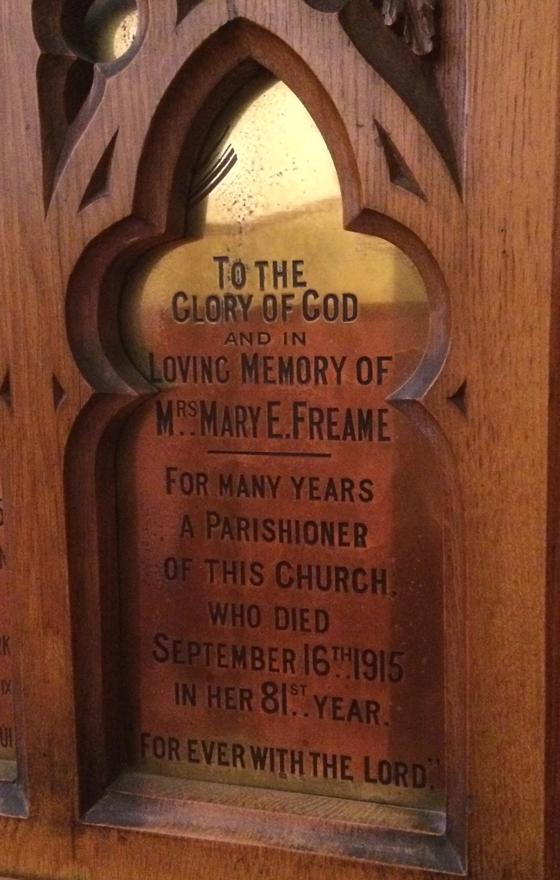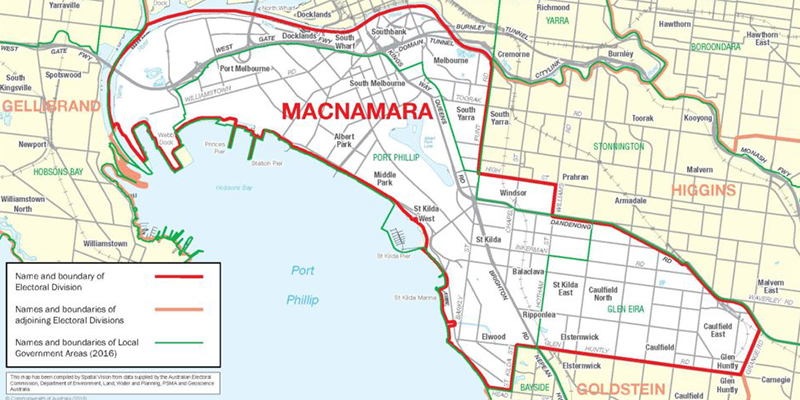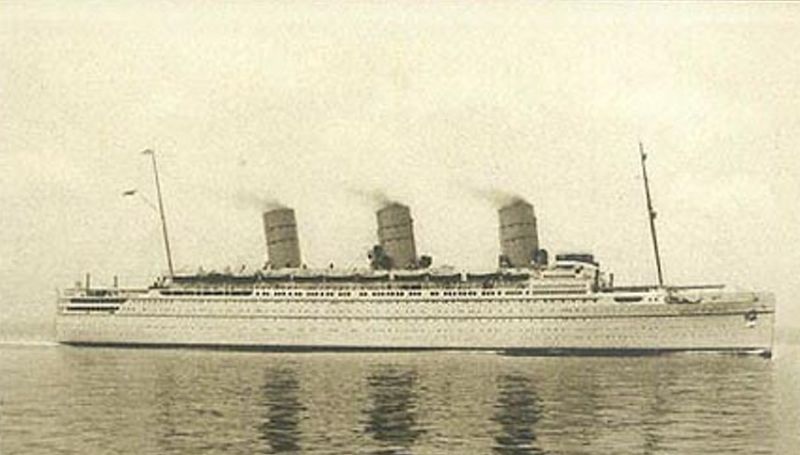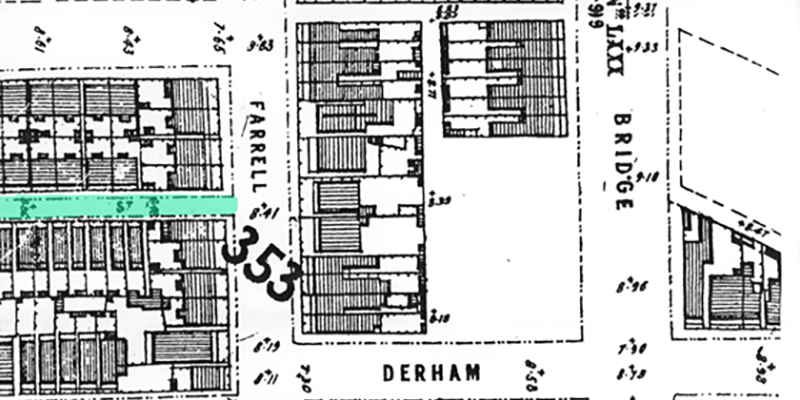The Freame Families of Port Melbourne
by Ray Jelley
‘there was a sheep dressed up to represent Carbine II with his jockey; Bunny Hare all ready to run for the Port Melbourne Cup; saddles of mutton in fanciful designs; poultry and geese formed from the shoulders of mutton; pigeons, made of suet, flying about the windows …’
proclaimed the Standard on 18 May 1895 when describing the display in Frank Freame’s butcher shop window at the corner of Graham and Princes Street. Frank’s birth name was Francis John Freame, but in the relaxed atmosphere of Port Melbourne he was simply known as Frank. Obviously, Frank not only had a flair for flamboyantly displaying his fare, but also a sense of humour.
However, Frank’s was not a singular Freame family living in Port Melbourne. In the 1864 directory there were two Freame families living in Sandridge, Francis (Frank) in Stokes Street and James in Railway Place. James was Frank’s brother who had his boot-making business in Stokes Street between Beach and Rouse Streets. From the early 1860s, James the elder and father of Frank and James, had a boot-making business in Peel Street, Prahran and then St David’s Street in St Kilda. The 1872 rate book for the City of Prahran shows that in 1872 Francis James Freame bought the premises in Peel Street from James Freame. William Freame, Frank’s younger brother and a bootmaker like his father and brothers James and Thomas, was also located in Prahran in 1873, but by 1878 he had moved to Sandridge and into premises in Bridge Street. In 1877, Eliza Freame, James the elder’s wife died, and the funeral left for the St Kilda Cemetery from Frank’s house in Graham Street. In 1878, James Freame had premises in Union Street, Prahran. When James the elder died in 1881, his funeral also left for the St Kilda Cemetery from Graham Street. By the time, the 1885 directory was compiled there were six separate addresses for the expanding Freame clan in Port Melbourne. There were three bootmakers: James, Thomas and William, all sons of the elder James, in Graham, Princes and Bay Streets respectively, and Frank with his butcher shop still on the corner of Graham and Princes Streets. In addition, there was Edmund Freame[1] an engine fireman at 110 Stokes Street as well as mention of a Freame living at 89 Ross Street, although the directory for Port Melbourne does not reflect this. The 1885 directory also includes the description of F J Freame ‘shipping butcher’ for the first time. Frank’s business had successfully expanded and was now supplying the many ships that arrived in Port Melbourne. A rudimentary census of the Freame family members living in Port Melbourne in 1885 was about twenty-five.
An indication of the impact that the Freame family had on Port Melbourne can be sensed when a search of the local newspapers between 1861 and 1920 for articles that included the name Freame revealed almost one thousand. Several of the articles were about Frank and his business, but equally importantly there were articles about Mary Elizabeth Freame, Frank’s wife. Born Mary Elizabeth Thomson in Van Diemen’s Land in about 1834 to parents John Wood Thomson and Sophia Tatham, Mary had married Frank in 1861 in St Kilda. Together they had thirteen children although eight died in infancy. Mary’s parents were described as ‘well and widely known to the early pioneers’, having arrived in the colony in about 1846.[2]
Following Mary’s death in 1915 she was described in the Age as being ‘distinguished for her charity and good work in connection with the Port Melbourne Church of England’.[3] Mary devoted over 50 years of her life to working for the Holy Trinity Church and was fondly remembered by all the members of the church when a plaque was placed on the pulpit in her honour (see photograph below). Her community work included providing much support to the people of Port Melbourne who suffered during the financial crash of the late 1880s. In addition, the Freame family were acclaimed in the Standard for being ‘large contributors to the evenings enjoyment, and the effort of himself [Frank] and the Misses and Master Freame were loudly applauded’ during a gathering in 1887 at the Sailor’s Rest.[4]
The 1900 directory shows that there were six addresses in Port Melbourne where members of the Freame clan lived. In addition, the directory listed that Frank Freame had two butcher shops in Port Melbourne as well as one in Flinders Street, Melbourne and another in Clarendon Street, South Melbourne. James and William were still bootmakers, and William had a shop in Russell Street, Melbourne, Edmund was an engine driver, Frank Jnr was a butcher, and William Jnr was a labourer. Repeating the earlier census, it is probable that there were thirty-six members of the Freame families living in Port Melbourne at that time.
The name Edmund was one that also appeared in a few Freame families. The Edmund referred to above was the son of George Freame (James the elder’s younger brother) who had arrived in Victoria in 1861 with another four members of his family. Edmund had gone from being a black-smith’s striker to engine fireman and finally an engine driver. At the turn of the century he and his wife Mary had seven children and were living at 23 Stokes Street.
The year 1900 brought tragedy for the Freame family when Frank Jnr died after he was overcome by carbon monoxide fumes from the un-flued gas water heater in their recently occupied house over their butcher shop on the north west corner of Bay and Pool Streets.[5] Frank was thirty-seven and left a wife and three children.
During the First World War two of the Port Melbourne Freame family clan joined up. They were Francis James Freame, son of Frank Jnr, born 1890 and Edmund Freame, son of Edmund Lawrence, born 1893. Edmund was the first to enlist on 26 October 1914 and was posted to ‘D’ Company of the 5th Battalion. He fought on the Gallipoli Peninsula where he was wounded and after recovering went to the Western Front in March 1916. The horrors of the July battle for Pozières put Edmund in hospital suffering from shellshock. Christopher Wray described the German barrage that fell on the Australians as ‘such as they had never before experienced. Shells “fell like hail in a storm”’… ‘[t]he shells which were dropping almost perpendicularly could be clearly seen on the last forty feet of their descent and the whole trench was methodically dealt with’.[6] After another period of time in hospital he returned to his unit in June 1917. During the battle for Glencorse Wood in Belgium, Edmund was one of seventy who were killed in action on 20 September 1917.
Francis James enlisted on 13 October 1916 and was posted direct to the Western Front and 1st Anzac Headquarters where he was assigned as a driver in ‘K’ supply column. He was killed on 29 October 1917 during the battle for Passchendaele. The War Diary was very matter of fact: ‘29/10/17 One driver “K” Supply Column was killed today by enemy shell fire’.[7]
In 1920 there were five Freame family addresses in Port Melbourne, still showing a dominant presence there. But by the time the 1925 directory was compiled there were none. The families’ footprints were for many years all over Port Melbourne. When Frank died in 1920 his real estate holdings in Port Melbourne amounted to ten properties.
This is but a snapshot of the Freame family and their lives’ journeys through Sandridge and Port Melbourne, but it can unequivocally be concluded that their presence in Port Melbourne was of great historical significance.
The society is interested in obtaining any images that may be available of members of the Freame family, and in particular Mary Elizabeth Freame.

[1] Edmund was listed under the name Edward at numerous times in both the Sands & McDougall and Rate Books but was confirmed as Edmund Lawrence Freame who was an engine driver and son of George Freame.
[2] ‘About People,’ Age, 18 September 1915, p. 11.
[3] Ibid.
[4] ‘Items of News,’ Standard, 29 January 1887, p. 2.
[5] ‘Francis John Freame,’ Australia, Victoria, Inquest Deposition Files, 1840-1925, available from <https://www.familysearch.org/ark:/61903/1:1:Q24C-5YFL>
[6] Christopher Wray, Pozières: Echoes of a Distant Battle (Port Melbourne: Cambridge University Press, 2015), p. 41.
[7] AWM4 Australian Imperial Force War Diaries, 1914-18 War, Supplies and Transport, 25/23/9, Headquarters Australian Corps, Mechanical Transport Column, October 1917, p. 2.



